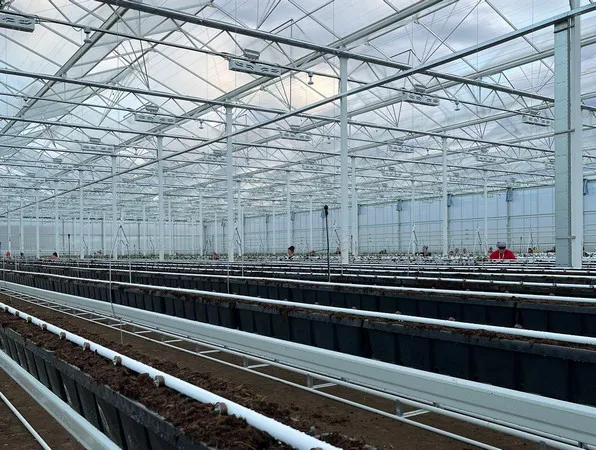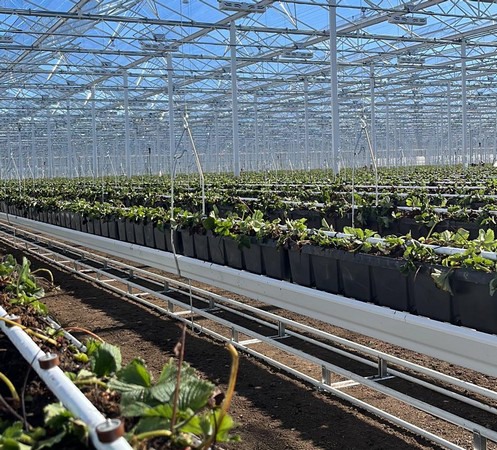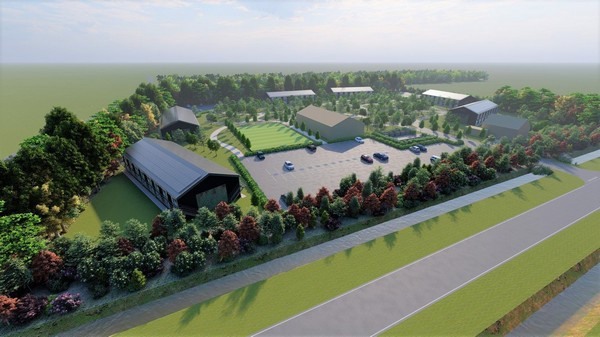With all that's going on at the moment, these are already very trying times for growers. However, growers who are in the middle of building a new greenhouse as well, are going through an even more intensive time. Jan van Genderen of Royal Berry is one of those growers. Before the energy crisis hit, he decided to build new greenhouses, and he went through with it. In early September he proudly showed us the results.
"The last window went in on 16 August. That very day the first plant went into the greenhouse," the strawberry grower explains, pointing to some photos of a greenhouse full of new strawberry plants. First, the Elsanta variety was planted in the 6,5 hectare greenhouse. This would be cultivation without artificial lighting. Meanwhile, the second half of the expansion is also up for planting, a 5.5 hectare greenhouse with LED lighting full, of Sonata, planted on September 6. "Here, we will be growing with full LED lighting this winter."
Planting date being met
The fact that these greenhouses are now full of plants is quite an achievement, certainly when Jan explains the challenges he and his construction partners faced. "The goal was always to plant on August 17. However, when war broke out in Ukraine, where we intended to source our glass, things got a bit tense. In the end, the glass came from China and it arrived on time. This was a great achievement and the result of excellent good cooperation by all parties. Remember, we faced container shortages, Covid and closed ports, to name just a few challenges. All parties involved made what seemed impossible possible."
The strawberry grower realizes that it has demanded a lot from his people and the construction partners. "Perhaps sometimes to the despair of some, adjusting the planting date of August 17 was not negotiable, in part because of the skyrocketing energy prices. Us achieving this, that's something I am very proud of. Everyone has done a great job, in what has been quite a tumultuous summer", says Jan, referring to the extreme heat. Everyone will understand that it's no easy job to glaze a greenhouse in those circumstances.

When asked if Jan ever considered postponing the construction of the greenhouse, he says that there have been times when he has thought about it. "But I never seriously considered it. You already have agreements for the delivery of your plants and also ideas about and agreements for your sales. Building is very intensive, but I also thought: the longer it takes, the harder it will become. In the end, it is an advantage to be able to roll through it quickly and start growing again. Although I'll be honest with you: if I had known what the gas price was going to be when I decided to build the greenhouse, I think I would have made a different choice."
Winter cultivation with LED lighting
Now that he has the greenhouse full of plants, the strawberry grower is happy with what he has. "We deal with the situation," he says. In Royal Berry's case, that means no fixed-price gas for the new greenhouse. "We will be growing energy efficiently, without compromising on product quality," he says. In this regard, the LED lighting is a godsend for the grower. "Last winter, we gained experience with it in an existing greenhouse equipped with LEDs. Just as we started lighting that crop, gas prices shot up. Still, we were able to complete the crop in a good way."
With what has now been planted in the new lighted greenhouse, Jan aims to be on the market in terms of production by early November. Until mid-January, the plants should provide fresh strawberries. "With this, we are going to try to fill some of the gap that may occur as growers, who started earlier, are going to run out of production." For the other LED-lit greenhouse, the plan is to plant in late September. "There, we want a production peak during the holidays, continuing production until the end of January."

Energy-efficient
For winter cultivation, as for all growers, it is important to look at the situation almost from day to day, says Jan. "For example, if there is a dip in the energy price somewhere, perhaps you can fix part of it anyway," he says, thinking aloud. "In any case, you have to look critically at your exposure hours. The fact that we can dim the lamps helpst. You can expose at 100% for a shorter period, but you can also choose to expose at 60-70% power for a longer period. You look at this very thoroughly, always fixating on product quality.This has to be high. An artificially lit crop is an expensive crop. In my opinion, you have to do it right or not at all."
Once harvested, Royal Berry will package the product. Even here, things can sometimes change. When asked if growers are sometimes packing smaller volumes, Jan nods. "That happens. It's important that consumers can continue to buy our product now that everyone's purchasing power is under pressure. You can't fully pass on your extreme cost increases to the consumer. So we decrease the volumes, for example offering 400 grams instead of 500 grams. That does mean that you wil have excess volumes, if you have not already taken it into account. You then have to find other outlets for those volumes. With energy-intensive crops, you have to pay close attention to this, making the right choices."

In addition to fretting over the construction of a new greenhouse and all the cultivation strategies and choices, Royal Berry is working on another issue: expanding the premises.
Spreading the risks
The winter is challenging for strawberry growers, but the summer, especially these days with extreme weather, no less so. "In winter, you can still manage reasonably well, but in summer it is much more difficult. For the glasshouse crops, for example, this year we applied a coating to the deck to keep the heat out. Using that diffuse coating is good for the quality of your fruit." Throughout the year, Royal Berry counts on the varieties Elsanta, Sonata, Sonsation, Furore, and Malling Centenary. Next year, the Lady Emma variety will be added in a large-scale trial, in addition to 'at least ten varieties' that are trialled every year regardless.
Controlled cultivation is becoming increasingly important to ensure quality and availability, the grower notes. "As is dealing efficiently with your labor. Together, these are three very important themes, going forward into the future." And a future will be there for him, Jan says adamantly. "For me, it's not a question of 'can we continue?' but 'how will we continue?'. Also, for me personally it is not 'can I go on?', but 'how will I go on?'"
For more information:
Royal Berry
info@royalberry.eu
www.royalberry.eu
